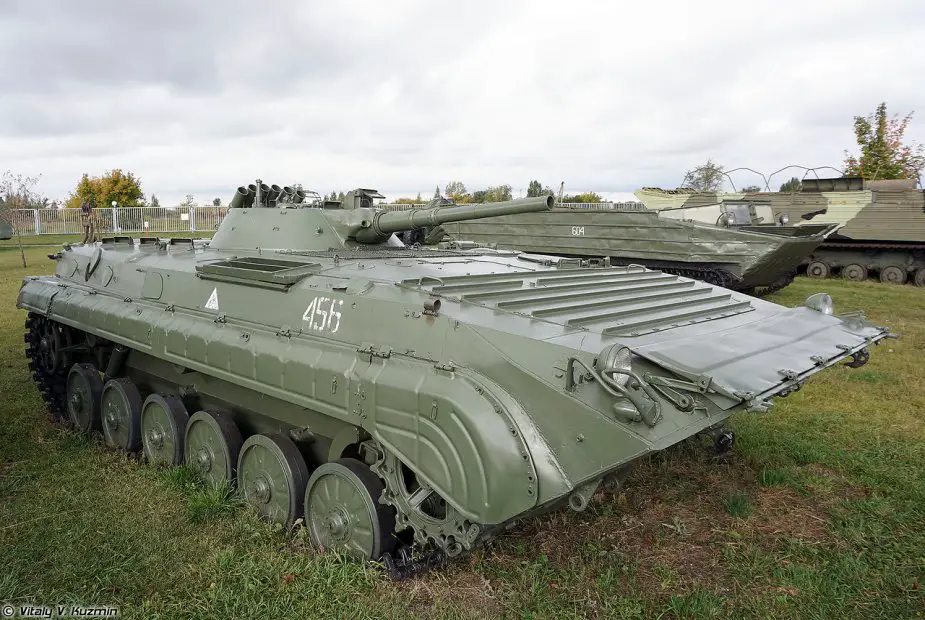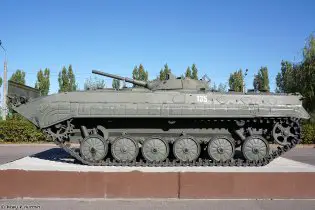- Army
- Air Defense Systems
- Anti-tank systems and vehicles
- Armored Vehicles
- Armoured personnel carriers
- Artillery Vehicles and Weapons
- Command Post
- Communication Vehicles and Systems
- Electronic Warfare
- Engineer | Maintenance Vehicles
- Infantry Fighting Vehicles
- Main Battle Tanks
- Missiles
- Tactical and Logistic Vehicles
- Radars
- Unmanned Systems
- Weapons
- Navy
- Air
BMP-1P
BMP-1P IFV
Tracked Armored Infantry Fighting Vehicle - Russia

Description
The BMP-1P is the first major modernization of the BMP-1, built in the mid-1970s. This modernization of the BMP-1 was the result of an analysis of its combat performance in conflicts such as the Yom Kippur War in 1973 and the Angolan civil war three years later. The enhancements aimed to strengthen its firepower by adding a pivot-mounted launcher, the 9P135M. This launcher featured a semi-automatic control system capable of firing SACLOS-guided ATGM (Anti-Tank Guided Missile) 9M113 "Konkurs" (AT-5 Spandrel) and 9M113M "Konkurs-M" (AT-5B Spandrel B). These improvements increased the armor penetration capability and extended the weapon's range.
However, the use of the new ATGM launchers posed some challenges. The gunner had to stand in the open hatch on top of the turret to operate the weapons, making them vulnerable to enemy fire. Additionally, in NBC (Nuclear, Biological, and Chemical) conditions, this configuration compromised the BMP-1P's NBC protection. To address this issue, the loading hatch of the Malyutka launcher was welded shut and the mounting was removed. Furthermore, a special NBC protection coating was applied inside and outside the turret, hull, upper engine compartment access hatch, commander's and driver's hatches, as well as underneath the driver's position.
Another significant improvement was the installation of a new fire suppression system for napalm protection. This modification was inspired by an analysis of armored fighting vehicle (AFV) usage during the Vietnam War. In terms of firepower, an additional machine gun firing port was added on the left side of the hull and at the front of the turret, bringing the total number of firing ports to nine. The BMP-1P weighed 13.5 tons and was built between 1979 and 1983. It was designated as the BMP M1981 by NATO.
BMP-1P variants:
- BMP-1PG (G for granatomyot, grenade launcher)
- BMP-1PM (no official Soviet designations)
- BMP-1PM1(no official Soviet designations)
- BMP-1PM2(no official Soviet designations)
- BMP-1PK (Command version)
Technical Data
| Armament |
|
The main armament of the BMP-1P is similar to the standard BMP-1 including one 73mm 2A28 gun capable of firing different types of ammunition, including explosive rounds and anti-infantry rounds, and one PKT 7.62mm machine gun.
One of the main improvements in terms of BMP-1P armament is the addition of a pivot-mounted (a small mast on the turret) 9P135M launcher, which enables the firing of ATGMs (Anti-Tank Guided Missiles). The missiles used are the 9M113 "Konkurs" (AT-5 Spandrel) and 9M113M "Konkurs-M" (AT-5B Spandrel B), both guided by the SACLOS (Semi-Automatic Command to Line Of Sight) system. This significantly enhanced the BMP-1P's capability to penetrate enemy armor and extend its firing range. In addition to the ATGMs, the BMP-1P was also equipped with a variety of other weapons. They also had a six barrels smoke grenade launcher (90 2B Tucha) at the back of the turret. The number of firing ports increased from 7 to 9. |
| Design and protection |
|
The BMP-1P had a similar design to the original BMP-1. Positioned at the front left side of the hull, the driver's compartment features a single-piece hatch cover that opens to the right. Directly behind the driver sits the commander, with a fully traversable cupola enabling a 360º field of view. The troop compartment, located at the rear of the vehicle, accommodates eight infantrymen seated back-to-back, four on each side of the hull. The entrance and exit for the infantry are facilitated by two doors located at the rear. These doors also serve as integral fuel tanks, holding 60 liters in the left door and 70 liters in the right door. Both doors are hinged on the outside and equipped with day vision devices, while the left door also features a firing port. The top of the hull is outfitted with four roof hatches, two on each side, hinged at the center, and capable of being locked in a vertical position.
|
| Mobility |
| The engine and transmission of the BMP-1P are to the right of the driver's and commander's positions with the steering system at the front of the hull. The air inlet and outlet louvers are at the top of the hull. The BMP-1 is motorized with a Type UTD-20 6-cylinder in-line water-cooled diesel developing 300 hp at 2,000 rpm coupled to a manual transmission with 5 forward and 1 reverse gear. The BMP-1P has a six-wheel suspension, rubber tires, and hydraulic shock absorbers. The suspension of the BMP-1P is the same as that of the BMP-1. |
| Combat Equipment |
| The BMP-1P is fully amphibious, propelled in the water by its tracks at a maximum speed of 7km/h. It can enter the water by erecting a trim vane at the front, activating bilge pumps, and replacing the driver's periscope. Additionally, it can create a smoke screen using the TDA engine thermal smoke generating system by injecting vaporized diesel fuel into the exhaust manifold. |
Specifications
| Armament | Armor |
| One 73mm 2A28 gun, one PKT 7.62mm machine gun, 1 launcher rail for Anti-tank guided missile AT-5 Spandrel or AT-5B Spandrel, one 902B Tucha smoke grenade launcher (6 barrels). | Protection against the firing of small arms and artillery shell splinters. |
| Country users | Weight |
| Bulgaria, Cuba, Georgia, Russia | 13.500 kg |
| Designer Country | Speed |
| Russia | 65 km/h maximum road speed, 7 km/h on water |
| Combat Equipment | Range |
| Infrared night vision, NBC protection system, fully amphibious | 550-600km |
| Crew | Dimensions |
| 3 + 8 Infantrymen | Length: 6.74 m; Width: 2.94 m; Height: 2.15 m |
Details View
 |
 |
 |
 |
Pictures - Video



























